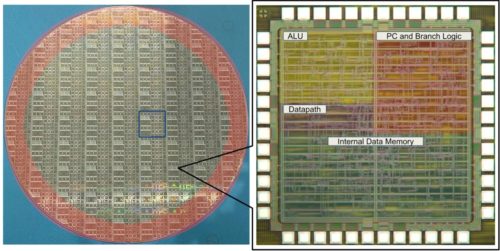
This new processor is made of plastic
Processors are components that are continuously stressed and, consequently, must be made of durable materials. This, however, also means having costs incurred for their production and with the surge in requests inherent in the world of IoT (Internet Of Things), it seems logical that some large companies have started to think of alternative solutions to power the billions of devices needed. every year.Apparently, a group of researchers seem to have found ways to build plastic processors that can be mass-produced for less than a penny. According to IEEE Spectrum, the new Flexicore chips have been optimized to reduce the number of components and complexity. In fact, it would be impossible to make plastic chips that replicate even the simplest current silicon microcontrollers. The Flexicore processor was born from the need to adopt a completely new architectural approach for the construction of plastic chips with acceptable yields and a very low price.
| crm_srl-th_hardware_d_mh2_1 slot id tag: th_hardware_d_mh2 "); }
In the future, researchers from the University of Illinois will seek to optimize CPUs for different processes and workloads. Certainly, the production of such chips will lead to the integration of electronic components virtually everywhere. The complete research will be presented at the International Symposium on Computer Architecture later this month.
Can Processors Be Made Of Plastics?
No one has yet developed functional processors that can be mass-produced in billions for less than a penny each… But if they’re made with plastics, this might actually be possible!
 Using PragmatIC’s manufacturing process to make a 4-bit microcontroller on plastic, engineers performed what they believe is the first yield study on plastic processors. (Credit: UNIVERSITY OF ILLINOIS/PRAGMATIC SEMICONDUCTOR)
Using PragmatIC’s manufacturing process to make a 4-bit microcontroller on plastic, engineers performed what they believe is the first yield study on plastic processors. (Credit: UNIVERSITY OF ILLINOIS/PRAGMATIC SEMICONDUCTOR)The issue is that even the most basic industry-standard microcontrollers are too sophisticated to mass-produce on plastic. A research team from the he University of Illinois reveals a simple yet fully working plastic processor that may be built for pennies. The team created 4-bit and 8-bit processors with the goal of reducing the size and increasing the percentage of working integrated circuits produced. According to team leader Rakesh Kumar, 81% of the 4-bit version operated, which is a good enough yield to break the one-penny barrier.
The processors his team created were produced with indium gallium zinc oxide (IGZO), a flexible thin-film semiconductor that can be put on plastic and still working even when twisted around a millimetre radius. While a dependable production method is essential, it was the design that made all the difference. Instead of adapting an existing microcontroller architecture to plastic, Kumar’s team created Flexicore from the ground up.
The researchers made the processor even simpler by constructing it to execute an instruction in a single clock cycle rather than the multistep pipelines used by today’s CPUs. Then they created logic that reuses parts to implement certain commands, lowering the gate count even more.
“In general, we were able to simplify the design of FlexiCores by tailoring them to the needs of flexible applications, which tend to be computationally simple,” says Nathaniel Bleier, Kumar’s student. All of this resulted in a 5.6-square-millimeter 4-bit FlexiCore with just 2,104 semiconductor devices (about the same amount of transistors as an Intel 4004 from 1971), compared to 56,340 for PlasticARM. “It’s an order of magnitude less than the tiniest silicon microcontrollers in terms of gate count,” he says.